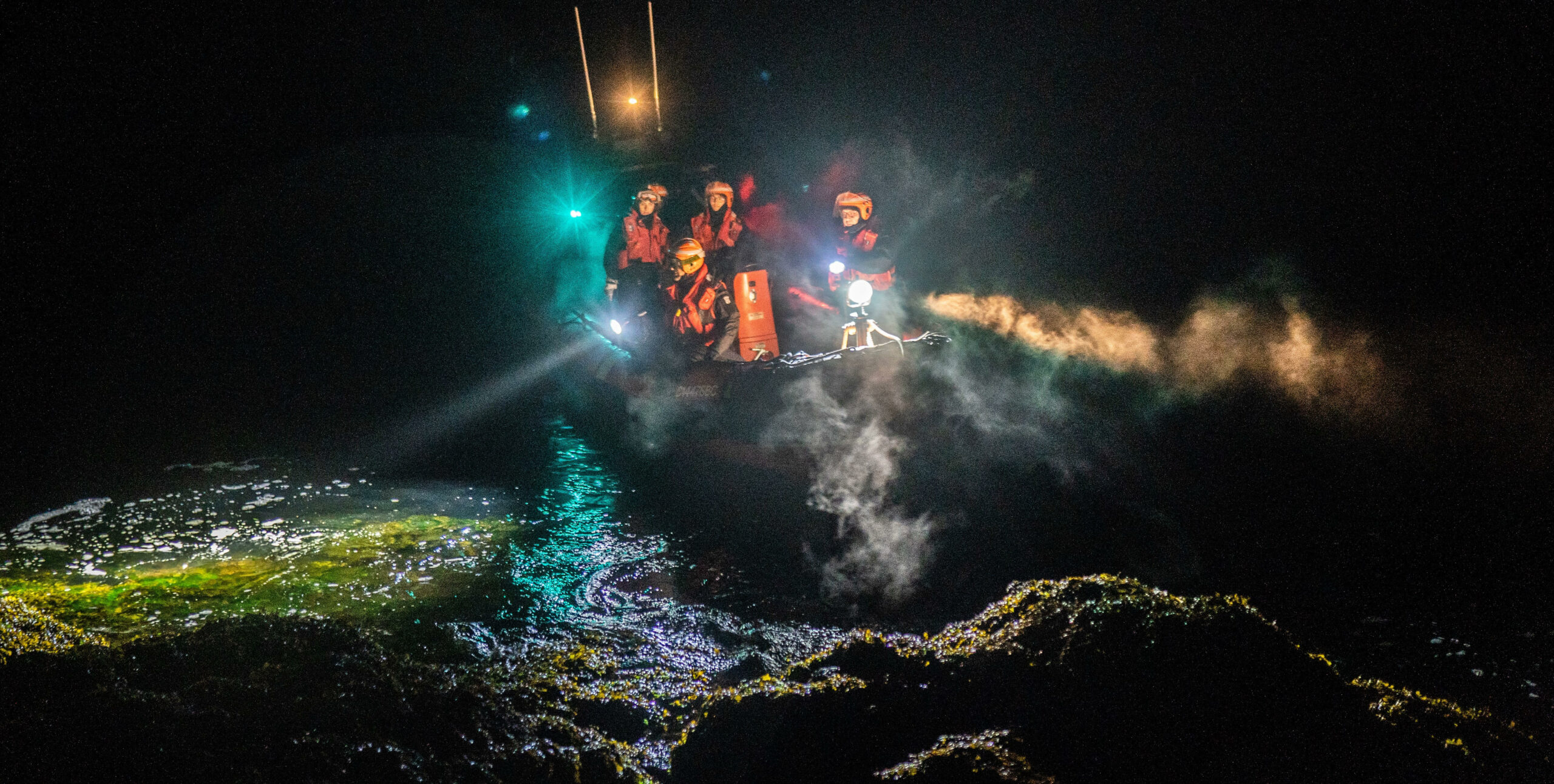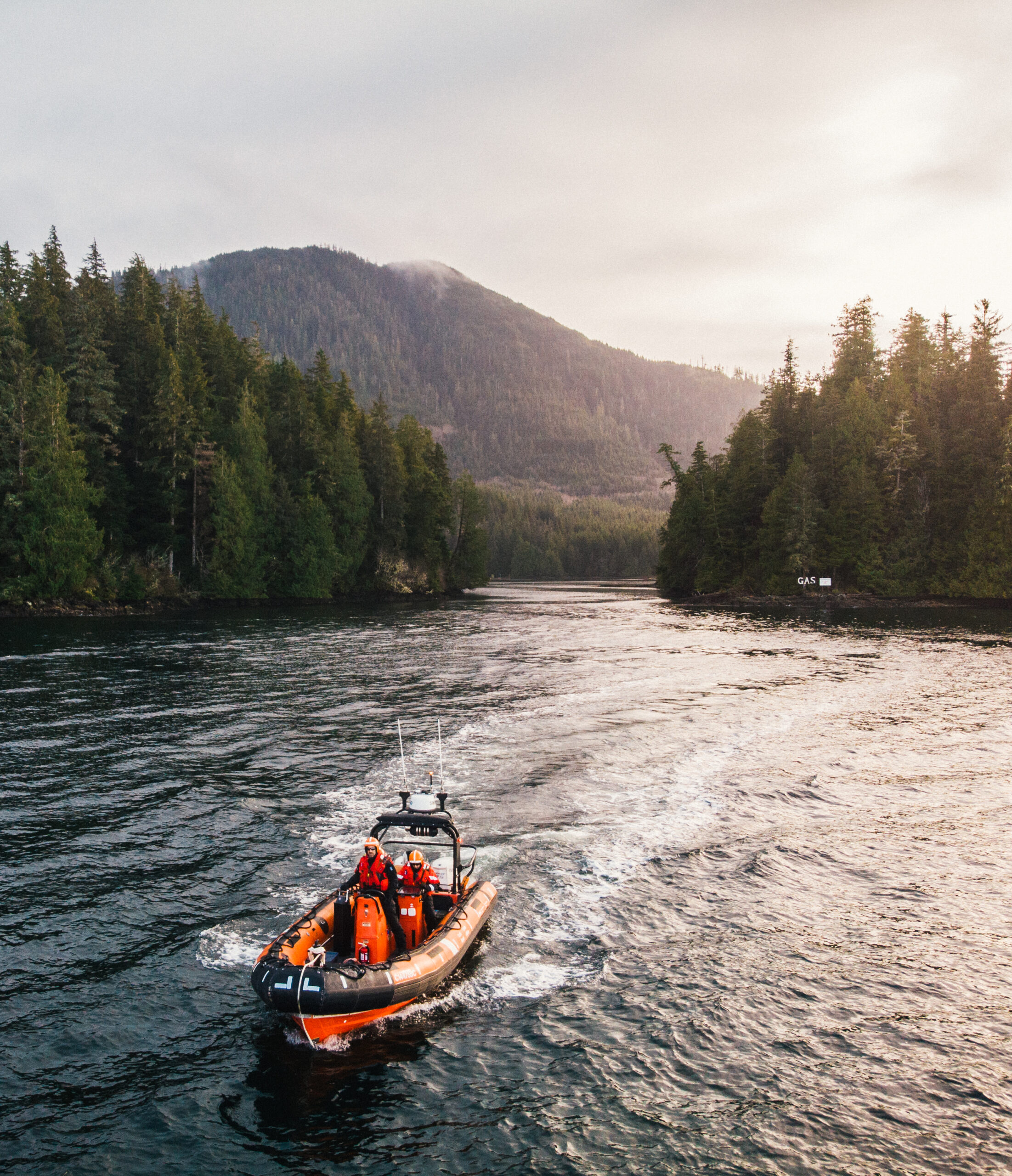
The Narwhal’s in-depth environmental reporting earns 11 national award nominations
From disappearing ice roads to reappearing buffalo, our stories explained the wonder and challenges of...
In mid-November, a storm pounded B.C.’s central coast, 120-kilometre-per-hour winds whipping the waves into a frenzy. The newly operational Coastal Nations Coast Guard Auxiliary dispatch centre in Bella Bella started receiving a flurry of calls for help from several vessels in distress.
“We had one vessel towing another vessel and he had to cut his tow loose. And we were told there was a person in the water,” Robert Johnson, Heiltsuk coordinator for the auxiliary, told The Narwhal.
Johnson said one boat sank and another was smashed against the government wharf in Bella Bella. But thanks to the coordinated efforts of the auxiliary, RCMP and Canadian Coast Guard, the rescues were completed safely.
B.C.’s coastal First Nations have lived, worked and thrived on the rugged west coast for millennia. Five nations — Ahousaht, Heiltsuk, Gitxaala, Nisga’a and Kitasoo — are now using intimate knowledge of the coast to save lives as Canada’s first Indigenous coast guard auxiliary.
While the auxiliary is focused on search and rescue, its mission of enabling communities to safely and efficiently respond to marine emergencies is a step toward the formation of an Indigenous marine response centre, which the Heiltsuk have been calling on governments to support since the Nathan E. Stewart, an articulated tugboat, ran aground and sank in 2016, spilling 110,000 litres of diesel into the Seaforth Channel near Bella Bella.
“We live on the coast, we live on the water and we will respond to any call for help.”
For Johnson, the auxiliary program is one part of a larger goal to protect the coast.
“I see it as a first step in bridging some gaps between government agencies and First Nations,” he said. “There’s a lot of gaps in there that need to be filled.”
The auxiliary has been in the works for four years as part of Canada’s Oceans Protection Plan, a $1.5-billion investment supporting initiatives that protect the country’s coastlines. The auxiliary is on call 24 hours a day, every day of the year. When deployed, members will complete rescue missions in tandem with the Canadian Coast Guard and other responders.
The program also involves training Indigenous members at a facility in Bamfield, on Vancouver Island, and in their home territories, and providing nations with equipment such as navigation systems, communications tools, first aid kits, survival suits and tow lines.

Dark and stormy nights are common on B.C.’s wild west coast. Members of the Coastal Nations Coast Guard Auxiliary have intimate knowledge of the geography, which allows them to expertly respond to emergencies on the water. Photo: Andrew Szeto / Coastal Nations Coast Guard Auxiliary
Many of the nations involved in the auxiliary have participated in rescue operations as first responders for decades. Members are still responding to emergencies in their own boats, but Conrad Cowan, executive director of the auxiliary, said two dedicated search and rescue boats will soon be sent to communities, and he is working on getting funding for another three.
“We live on the coast, we live on the water and we will respond to any call for help,” said Johnson, who’s been a responder for more than a decade. “But now that we’ve got the coast guard auxiliary, we’re able to respond with equipment that we’ve never had before.”
In 2015, Ahousaht fishermen spotted a distress flare sent from a Tofino-based whale watching vessel that capsized. The fishermen and other community members responded quickly, using knowledge of the currents, tides and weather. Their efforts led to the rescue of 21 people, but tragically six people died.
Roger Girouard, assistant commissioner for the Canadian Coast Guard, said the coast guard was involved that day, but the coordination of rescue efforts by First Nations and federal authorities was “lacking.”
“I’ll use that word bluntly — and honestly,” he said. “From that point on, we’ve been looking at how to be better together on the water.”

The Canadian Coast Guard is providing training for members of the Indigenous auxiliary, but Roger Girouard, assistant commissioner for the coast guard, said his team is learning just as much from the trainees. Photo: Andrew Szeto / Coastal Nations Coast Guard Auxiliary
The first step, he said, was building relationships with the First Nations along the coast.
“I remember going out to visit Chief Greg Louie in Ahousaht to thank him for his community’s efforts in that incident, but also to apologize that we had not learned how to be better connected with his community or indeed, in a number of places around the coast,” Girouard said. “So we struck out to improve those relationships one by one.”
He said he and his team travelled the coast, asking each community what it would like to see and what it wanted its relationship with the coast guard to be. The answer took time to form, but he said it became clear that an Indigenous-led auxiliary was a good place to start.
“In the grand scheme of things, it’s not an expensive program, but the return on the investment in terms of ability, confidence on the water and a sense of self-reliance for these very isolated communities is what really makes it magic.”
The coast guard has had volunteer auxiliaries across Canada since 1978. Its members respond to about a quarter of all marine search and rescue events. The Indigenous auxiliary is unique in that it is accessing funding for equipment through the Oceans Protection Plan, while other auxiliaries require members to provide their own gear. Cowan said the annual operational funding they receive from the Canada Coast Guard, however, is on par with other auxiliaries.
Girouard added that the training the Canadian Coast Guard is providing Indigenous members doesn’t look the same as typical auxiliary training.
“We don’t show them how to drive a boat — we know they know that. We don’t teach them their geography, they already know that too. What we bring to the table is skills that they haven’t got.”

Members of the Coastal Nations Coast Guard Auxiliary participate in a search and rescue training exercise near Bamfield, B.C. Photo: Andrew Szeto / Coastal Nations Coast Guard Auxiliary
Members have been provided with courses like advanced marine first aid, swiftwater rescue and COVID-19 protocols for frontline workers. Members are also taught well-established search and rescue techniques and protocols. Girouard said the volunteers are also teaching his staff.
“My team is learning as much from these Indigenous mariners as they are from us. It’s growing this really lovely community, where you know how to read a current or you know what the birds are telling you about the weather.”
Cowan agreed. “These are seasoned mariners. They know their waters very, very well — the tides, the ebbs and the flows, the spots that are foggy or not foggy.”
Cowan, who has spent the past 17 years on the frontlines of search and rescue, including for the air force, said it would take him a very long time to achieve members’ existing skill sets, if he could at all.
“There’s one more person alive because of this work that we’ve been doing.”
But the training is valuable nonetheless and Girouard said it’s already paying off.
On what he describes as a “classic dark and stormy night,” a broken radio call came in. An Indigenous responder quickly used his combined knowledge of the territory and the skills he had learned during training to run a search pattern, a systematic search method designed to increase the chances of finding a person in the water.
“Lo and behold, 30 minutes into a search pattern, he came across a guy clinging to a log and got him out alive.”
For Girouard, that’s the payoff.
“There’s one more person alive because of this work that we’ve been doing.”
For the First Nations along the coast, protecting the environment is as much a priority as saving lives.
Heiltsuk volunteers were the first responders to the site of the Nathan E. Stewart, and four years later, the disaster is still impacting the community.
“We still can’t harvest our food out there,” said Johnson, who was one of the first on scene and one of the last to leave.
An independent report commissioned by the Heiltsuk Tribal Council following the disaster noted a slow response time, inadequate equipment and poor communication. The Heiltsuk have proposed to establish an Indigenous marine response centre near Bella Bella, which would be able to respond to a spill anywhere in Heiltsuk territory in less than five hours. The centre would be equipped with a fleet of rapid response vessels and spill-response equipment.
Girouard acknowledged that protecting the environment is a priority for Indigenous and colonial governments alike.
“We’re talking about life and limb,” Girouard said. “But of course, the other thing that nations are really keen to do is protect the shoreline. They want to protect fin and feather. They want to protect the breadbasket. And so it’s a conversation that is as alive as search and rescue.”
He said he wasn’t able to speak specifically to plans for an Indigenous-led spill response centre because discussions between the Heiltsuk and federal and provincial governments are still underway, but he supports the idea.
“It’s no secret that for the last few years, we’ve been doing a lot of spill planning work with the First Nations up and down the coast,” he said. “We believe we need to start deploying more equipment, which Canada is investing in, and that equipment shouldn’t just sit in Victoria or Prince Rupert.”
In an emailed statement, the B.C. Ministry of Environment and Climate Change Strategy said it has been involved in planning with the Heiltsuk Nation and the federal government.
“We welcome the proposal by the Heiltsuk Nation to improve spill response in the central coast and better involve Indigenous communities in a robust marine response regime.”
The Narwhal reached out to Transport Canada and Environment and Climate Change Canada, but agencies referred questions to the Canadian Coast Guard.
Johnson, who is part of a strategic planning team for the development of the centre, said plans are coming together and they’re in the process of looking for land where they can build the response centre.
In the proposal, Chief Councillor Marilyn Slett and Hereditary Chief Harvey Humchitt stress the need for community-based capacity.
“Indigenous communities have shown that we are and will continue to be the first responders to marine incidents in our waters. The time has come to meaningfully develop our capacity to properly address emergencies in our territories as they arise.”
Get the inside scoop on The Narwhal’s environment and climate reporting by signing up for our free newsletter. On a warm September evening nearly 15...
Continue reading
From disappearing ice roads to reappearing buffalo, our stories explained the wonder and challenges of...

Sitting at the crossroads of journalism and code, we’ve found our perfect match: someone who...

The Protecting Ontario by Unleashing Our Economy Act exempts industry from provincial regulations — putting...
